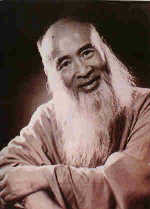 Zhang Daqian (1899-1983)is afamous artist in China's modern and contemporary cultural circles. He was born into a rich family in Neijiang, Sichuan Province. Zhang learned to draw (after his mother) when he was just 10 years old. At age12 he was already famous for his flower-and-bird paintings.Zhang devoted his whole life to Chinese painting and also indulged in poetry, seal cutting and calligraphy.
Zhang Daqian (1899-1983)is afamous artist in China's modern and contemporary cultural circles. He was born into a rich family in Neijiang, Sichuan Province. Zhang learned to draw (after his mother) when he was just 10 years old. At age12 he was already famous for his flower-and-bird paintings.Zhang devoted his whole life to Chinese painting and also indulged in poetry, seal cutting and calligraphy.
Zhang was versatile and brilliant in many techniques and styles of Chinese painting, likegongbi(meticulous brushwork), free sketches, ink-and-wash painting, heavy coloration, figure painting, paintings of birds and flowers and landscape painting. Not only did he epitomize the traditional art of painting, but he was a pioneer in blending the ideas and skills of traditional and modern painting, as well. Inspired by the splendid landscapes of his country, Zhang produced many beautiful and unforgettable works of art expressing his love for China. His practice, vigor and efforts in many great paintings have enhanced the renovation, development and prosperity of modern Chinese painting -- a remarkable contribution to its recognition in the field.
Zhang was one of the few painters to have copied great paintings of successive dynasties to a large extent. He strongly emphasized the exploration of traditional value through imitation.
It is of vital importance to learn from tradition, said Zhang. There is the long tradition of painting art and many great paintings left behind by our master painters in our country. In different societies and with the effort of all their lives, they accumulated much experience. We should learn and master the rich experience and apply it in practice to carry it forward and gradually form our own style. It is the endeavor for the whole life. It won't do without painstaking efforts.
Ever since the 1930s, Zhang and Qi Baishi were honored with the titles -- Zhang in the south and Qi in the north � meaning the best two Chinese painters of the time. Xu Beihong, a modern Chinese art master, once praised Zhang as the best painter in the recent 500 years.
Zhang, who was a lay Buddhist, also enjoyed many legends. His uniqueness in the artistic field of 20th-century China is not only in his persistent exploration, great achievements and influence, but also in his complex experiences and broad stages in social life participation.
At 42 years of age, Zhang became determined to leave the comfortable life in the city for a remote existence in Dunhuang to improve himself near the famous grotto walls. In two years and seven months, Zhang copied 276 frescoes from the Bei Wei Period, Sui Dynasty, Tang Dynasty and Five Dynasties. Now, 183 of his copies are preserved at the Sichuan Provincial Museum. Zhang's efforts in Dunhuang fresco-copying not only helped him reach a higher level of artistic attainment, but also made the Dunhuang paintings famous throughout and outside of China.
The second half of Zhang's life was mainly spent abroad promoting Chinese artistic civilization and cultural exchanges between China and Western countries. In 1958 Zhang was proclaimed The Best Contemporary Painter in the World by the International Fine Arts Association in New York, and was awarded a gold medal that was a great honor to the Chinese people.
After half a century, the charm of Zhang's artworks endures. His honor and prestige is founded on his talent, self-cultivation, broad mind, vision and diligent exploration and study throughout his entire life.
